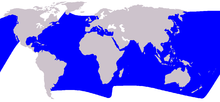Striped dolphin
| Striped Dolphin[1] | |
|---|---|

| |
| A Striped Dolphin in full flight | |

| |
| Size comparison against an average human | |
| Scientific classification | |
| Kingdom: | |
| Phylum: | |
| Class: | |
| Subclass: | |
| Order: | |
| Suborder: | |
| Family: | |
| Genus: | |
| Species: | S. coeruleoalba
|
| Binomial name | |
| Stenella coeruleoalba (Meyen, 1833)
| |

| |
| Striped Dolphin range | |
The Striped Dolphin (Stenella coeruleoalba) is an extensively studied dolphin that is found in temperate and tropical waters of all the world's oceans. It is a member of the family Delphinidae of toothed whales.
Taxonomy
The Striped Dolphin is one of five species traditionally included in the genus Stenella; however, recent genetic work by LeDuc et al. (1999) indicates that Stenella, as traditionally conceived, is not a natural group. According to that study, the closest relatives of the Striped Dolphin are the Clymene Dolphin, the Common Dolphins, the Atlantic Spotted Dolphin, and "Tursiops" aduncus, which was formerly considered a subspecies of the Bottlenose Dolphin. The Striped Dolphin was described by Franz Meyen in 1833. The specific name coeruleoalba (from Latin caeruleus 'dark blue' and albus 'white') refers to the characteristic blue and white stripes on the flanks.
Physical description
The Striped Dolphin has a similar size and shape to several other dolphins that inhabit the waters that it does (see Pantropical Spotted Dolphin, Atlantic Spotted Dolphin, Clymene Dolphin). However its colouring is very different and makes them relatively easy to notice at sea. The underside is blue, white or pink. There are one or two black bands that circle the eyes, and then run across the back, to the flipper. These bands widen to the width of the flipper which are the same size. There are two further black stripes running from behind the ear - one is short and ends just above the flipper. The other is longer and thickens along the flanks until it curves down under the belly just prior to the tail stock. Above these stripes the dolphin's flanks are coloured light blue or grey. All appendages are black as well. At birth, individuals weigh about 10 kg (22 pounds) and are up to a meter (3 feet) long. By adulthood they have grown to 2.4 m (8 ft) (females) or 2.6 m (8.5 ft) (males) and weigh 150 kg (330 lb) (female) or 160 kg (352 lb) (male). Research suggest that sexual maturity was reached at 12 years in Mediterranean females and in the Pacific at between 7 and 9 years. Longevity is about 55–60 years. Gestation lasts approximately 12 months and there is a three or four year gap between calving.
In common with other dolphins in its genus, the Striped dolphin moves in large groups - usually in excess of up to thousands of individuals in size. Groups may be smaller in the Mediterranean and Atlantic. They may also mix with Common Dolphins. The Striped dolphin is as capable as any dolphin at performing acrobatics - frequently breaching and jumping far above the surface of the water. Sometimes, it approaches boats in the Atlantic and Mediterranean but this is dramatically less common in other areas, particularly in the Pacific where it has been heavily exploited in the past.
The Striped Dolphin feeds on small pelagic fish and squid.
Population and distribution
The Striped Dolphin likes temperate or tropical, off-shore waters. It is found in abundance in the North and South Atlantic Oceans, including the Mediterranean and Gulf of Mexico, the Indian Ocean and the Pacific Ocean. Roughly speaking it occupies a range running from 40° N to 30° S. It has been found in water temperatures ranging from 10 to 26 degrees Celsius, though the standard range is 18-22 degrees. In the western Pacific, where the species has been extensively studied, a distinctive migration pattern has been identified. This has not been the case in other areas. The dolphin appears to be common in all areas of its range, though that may not be continuous in areas of low population density do exist. The total population is in excess of two million.
Human interaction
Japan has hunted Striped Dolphins in the western Pacific since at least the 1940s. In the heyday of "striped dolphin drives", at least 8,000 to 9,000 individuals were killed each year and in one exceptional year 21,000 individuals were killed. Since the 1980s, following the introduction of quotas, this number has fallen to around 1,000 kills per year. Conservationists are concerned about the Mediterranean population which is threatened by pollution, disease, busy shipping lanes and heavy incidental catches in fishing nets.
Attempts have been made to keep the Striped Dolphin in captivity. However these have all failed, with animals dying within two weeks due to failure to feed.
Diet
The adult Striped Dolphin eats fish, squid, octopus, krill, and other crustaceans. Mediterranean striped dolphins seem to prey primarily on cephalopods (50-100% of stomach contents), while northeastern Atlantic striped dolphins most often prey on fish, frequently cod. They mainly feed on cephalopods, crustaceans, and bony fishes. They feed anywhere within the water column where prey is concentrated and they can dive to depths of 700 metres to hunt deeper-dwelling species.
Conservation
The Eastern tropical Pacific and Mediterranean populations of the Striped dolphin are listed on Appendix II [3] of the Convention on the Conservation of Migratory Species of Wild Animals (CMS), since they have an unfavourable conservation status or would benefit significantly from international co-operation organised by tailored agreements.
In addition, the Striped dolphin is covered by the Agreement on the Conservation of Small Cetaceans of the Baltic, North East Atlantic, Irish and North Seas (ASCOBANS), the Agreement on the Conservation of Cetaceans in the Black Sea, Mediterranean Sea and Contiguous Atlantic Area (ACCOBAMS), the Memorandum of Understanding for the Conservation of Cetaceans and Their Habitats in the Pacific Islands Region (Pacific Cetaceans MOU) and the Memorandum of Understanding Concerning the Conservation of the Manatee and Small Cetaceans of Western Africa and Macaronesia (Western African Aquatic Mammals MoU)
References
- ^ Mead, J. G.; Brownell, R. L. Jr. (2005). "Order Cetacea". In Wilson, D. E.; Reeder, D. M. (eds.). Mammal Species of the World: A Taxonomic and Geographic Reference (3rd ed.). Johns Hopkins University Press. pp. 723–743. ISBN 978-0-8018-8221-0. OCLC 62265494.
- ^ Template:IUCN2008
- ^ "Appendix II" of the Convention on the Conservation of Migratory Species of Wild Animals (CMS). As amended by the Conference of the Parties in 1985, 1988, 1991, 1994, 1997, 1999, 2002, 2005 and 2008. Effective: 5th March 2009.
- LeDuc, R.G., W.F. Perrin and A.E. Dizon (1999). Phylogenetic relationships among the delphinid cetaceans based on full cytochrome b sequences. Marine Mammal Science, vol. 15, no. 3:619-648.
- Striped Dolphin by Frederick I. Archer II in Encyclopedia of Marine Mammals pp. 1201–1203. ISBN 978-0-12-551340-1
- Eds. C.Michael Hogan and C.J.Cleveland. 2011. Striped dolphin. Encyclopedia of Earth with content partner EOL, National Council for Science and Environment, Washington, DC
- Whales Dolphins and Porpoises, Mark Carwardine, Dorling Kindersley Handbooks, ISBN 0-7513-2781-6
- National Audubon Society Guide to Marine Mammals of the World, Reeves, Stewart, Clapham and Powell, ISBN 0-375-41141-0
External links
- ARKive - images and movies of the striped dolphin (Stenella coeruleoalba)
- Whale and Dolphin Conservation Society
- Whale Trackers - An online documentary series about whales, dolphins and porpoises.
- Convention on Migratory Species page on the Striped dolphin
- Official website of the Agreement on the Conservation of Cetaceans in the Black Sea, Mediterranean Sea and Contiguous Atlantic Area
- Official website of the Agreement on the Conservation of Small Cetaceans of the Baltic, North East Atlantic, Irish and North Seas
- Official website of the Memorandum of Understanding for the Conservation of Cetaceans and Their Habitats in the Pacific Islands Region
- Memorandum of Understanding Concerning the Conservation of the Manatee and Small Cetaceans of Western Africa and Macaronesia

